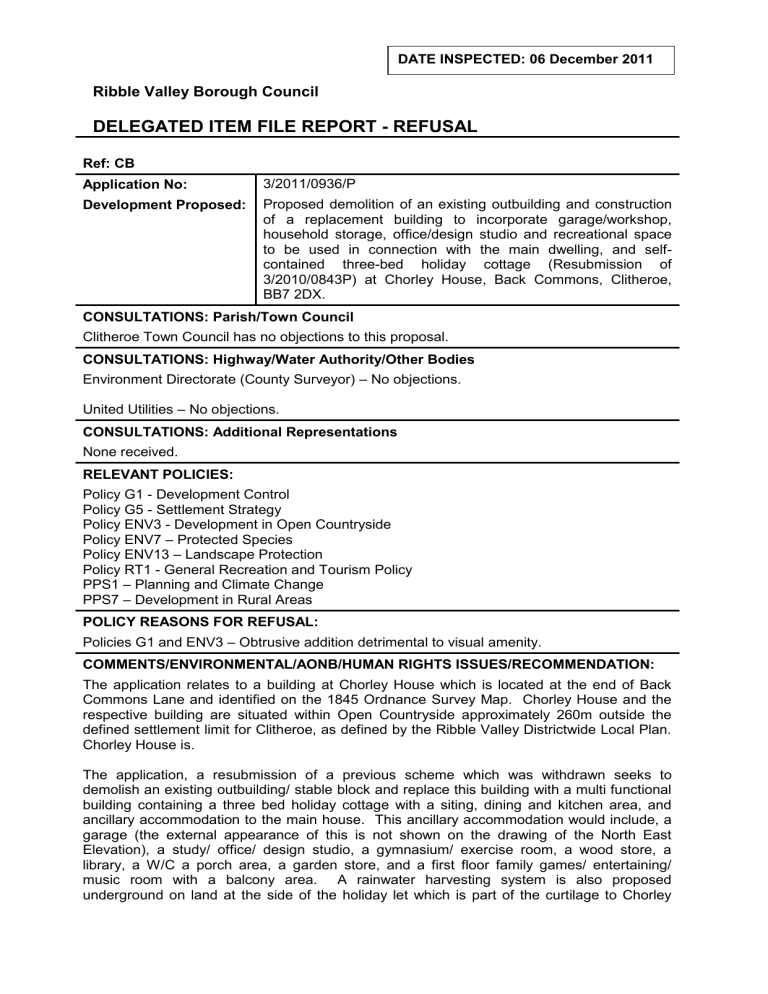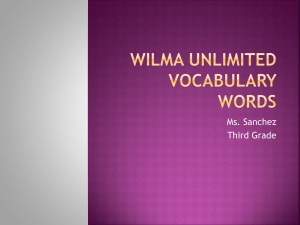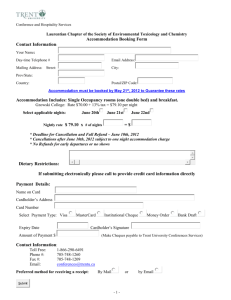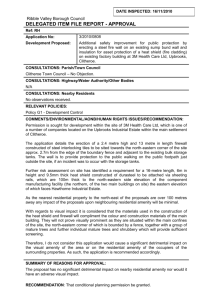2011_0936 Deleg Refusal Chorley House.do

DATE INSPECTED: 06 December 2011
Ribble Valley Borough Council
DELEGATED ITEM FILE REPORT - REFUSAL
Ref: CB
Application No: 3/2011/0936/P
Development Proposed: Proposed demolition of an existing outbuilding and construction of a replacement building to incorporate garage/workshop, household storage, office/design studio and recreational space to be used in connection with the main dwelling, and selfcontained three-bed holiday cottage (Resubmission of
3/2010/0843P) at Chorley House, Back Commons, Clitheroe,
BB7 2DX.
CONSULTATIONS: Parish/Town Council
Clitheroe Town Council has no objections to this proposal.
CONSULTATIONS: Highway/Water Authority/Other Bodies
Environment Directorate (County Surveyor) – No objections.
United Utilities – No objections.
CONSULTATIONS: Additional Representations
None received.
RELEVANT POLICIES:
Policy G1 - Development Control
Policy G5 - Settlement Strategy
Policy ENV3 - Development in Open Countryside
Policy ENV7
– Protected Species
Policy ENV13 – Landscape Protection
Policy RT1 - General Recreation and Tourism Policy
PPS1 – Planning and Climate Change
PPS7 – Development in Rural Areas
POLICY REASONS FOR REFUSAL:
Policies G1 and ENV3 – Obtrusive addition detrimental to visual amenity.
COMMENTS/ENVIRONMENTAL/AONB/HUMAN RIGHTS ISSUES/RECOMMENDATION:
The application relates to a building at Chorley House which is located at the end of Back
Commons Lane and identified on the 1845 Ordnance Survey Map. Chorley House and the respective building are situated within Open Countryside approximately 260m outside the defined settlement limit for Clitheroe, as defined by the Ribble Valley Districtwide Local Plan.
Chorley House is.
The application, a resubmission of a previous scheme which was withdrawn seeks to demolish an existing outbuilding/ stable block and replace this building with a multi functional building containing a three bed holiday cottage with a siting, dining and kitchen area, and ancillary accommodation to the main house. This ancillary accommodation would include, a garage (the external appearance of this is not shown on the drawing of the North East
Elevation), a study/ office/ design studio, a gymnasium/ exercise room, a wood store, a library, a W/C a porch area, a garden store, and a first floor family games/ entertaining/ music room with a balcony area. A rainwater harvesting system is also proposed underground on land at the side of the holiday let which is part of the curtilage to Chorley
House.
This application seeks to change the design of the proposed holiday let and ancillary accommodation building, previously withdrawn. Permission is therefore sought to erect a part single storey, part two storey building with a floor area of 436.73m which would have approximate dimensions of 22.8m x 22.5m. To eaves level on the two storey central element the building would measure 5.3 metres high and to the pitch 8.0 metres. The building would be split 64.3%/ 35.7% with the largest proportion being ancillary accommodation to the main dwelling and the smaller portion being used for holiday accommodation.
The proposal seeks to demolish the existing painted rendered outbuilding with a corrugated asbestos roof at the property, which is located to the south west of the main house, and to site the new builing on part of its footprint. Up until 1996 the outbuilding was used to stable the applicants youngstock/ racehorses and these stables still exist internally. The existing floor plan and design and access statement submitted shows these stables being used to store a number of domestic goods, including a fish tank, trampoline and the family car. It has approximate dimensions of 22.8m x 10.7m x 3.5m to the eaves and 6.3m to the pitch. The existing building has a footprint of 24 3.96m², The difference in floor area between the existing building and that proposed is 192.77m² an increase of 79%.
The front elevation of the proposed building would be seen as single storey and would be viewed with a two storey hipped roof addition behind. The single storey element illustrates two arched doorways with a round window positioned centrally above within the apex. The archways are shown on the elevation drawing as being covered with timber doors, however, the floor plans show these as window openings which would serve bedrooms 2 and 3 within the holiday let. Single storey elements would project from either side, with the two storey hipped roof element set behind. This two storey part would have tri/bi-folding doors at both ground and first floors, and the first floor area would have a glazed balcony projecting from the rear by approximately 1.5m. The balcony would be 4.0m wide and have a height of 3.1m.
A chimney stack with three chimney pots would be positioned on the corner of south-west corner of the two storey element. These three chimney pots would provide fire places within the ancillary accommodation and serve the ground floor gym/ exercise room, the study/ office/ design room and the first floor entertaining/ games room.
Following the withdrawal of the previous scheme, it was suggested at pre-application stage that any replacement building would need to appear simple in design and ancillary to the main dwelling, and the Agent was told that a two storey building is unlikely to be acceptable given the long range views of the site within this rural location.
The main matters for consideration include the principle of development, highway safety, protected species and visual amenity.
The site in question is located outside the settlement boundary of Clitheroe within land designated as open countryside, as defined by the Ribble Valley Districtwide Local Plan
(DWLP). The policies relevant to this mixed use application are local plan polices G1, ENV3,
ENV7, ENV13, RT1 and national planning statements PPS1 and PPS7.
Policy G5 allows for small scale tourism/ visitor developments in areas outside defined settlement limits which are appropriate to a rural area subject to policy RT1 and other relevant policies within the Plan. Policy G5 also allows for small scale uses appropriate to a rural area. The proposed ancillary accommodation can also be assessed under this Policy.
Considering the floor area of the ancillary accommodation would replace an existing building and would be larger than the existing building by some 15% it could be considered that this increase is acceptable in terms of compliance with Policy G5.
It is questionable whether the land at the side of the existing building and on which part of the
building would be located is part of the residential curtilage. Whilst it is acceptable that the outbuilding (the former stables) has been used for domestic storage purposes, the land at the side, a former sand paddock, is clearly shown as being of a different nature to that of the garden area at the rear of the main house on the Ariel photographs from 2002 and 2009.
Questions are therefore raised over this land.
Policy RT1 of the DWLP supports development proposals which extend the range of tourism and visitor facilities in the Borough. The Policy requires proposals to be physically well related to an existing a main settlement or to an existing group of buildings. This site is located in a relatively isolated position; however, it is within 270 metres of the main settlement limit for Clitheroe. Furthermore, the building would be seen as part of a group of buildings and thus in locational terms the proposal is acceptable. Other planning considerations such as highway safety, visual amenity and residential amenity need to be assessed against the relevant policies.
In terms of visual amenity, this area of open countryside is characterised by detached isolated farmhouses. Chorley House is identified on the 1845 O.S map and its linear form is clearly still evident. The existing views of this site from the nearby PROW are of the main dwelling and of the agricultural/ horsicultural building to the West of the farmhouse. The outbuilding is both linear and simple in design and utilitarian in appearance, and it is clearly seen as an ancillary rural outbuilding to the main dwelling.
Policy G1 of the DWLP requires development to be sympathetic to existing and proposed land uses in terms of its size, intensity and nature. Policy ENV3 also requires development to be in keeping with the character of the landscape area. It states that new development should reflect local vernacular, scale, style, features and building materials whilst conserving, renewing or enhancing landscape features. In considering these policies, the proposed mixed use building would, in my opinion, completely change the rural character and appearance of this area to its detriment. Moreover, I am of the opinion, that the proposed building, due to its size, design, scale, massing and siting, would appear as a separate and standalone building which is more akin to a substantial residence and not as ancillary domestic accommodation. Furthermore, nor would the building appear as simple rural visitor accommodation. The design and appearance of the building would result in a visually intrusive addition, out of keeping with the local vernacular, and this, in my opinion, would be detrimental to the visual amenities of the locality, which despite being relatively close to the
Town Centre is rural in nature given its standalone position surrounded by farmland. I note that since the previous application, trees are proposed to be planted along the south-eastern boundary, however, I do not consider that this would make this proposal acceptable.
In terms of highway safety, the LCC Highway Engineer, is satisfied that there is sufficient parking within the site for both the occupants of Chorley House and visitors to the holiday let.
In relation to protected species, the submitted bat survey states that the existing building is unlikely to be used for bats and therefore the proposed building would be unlikely to cause disturbance to the local bat population.
While the principle of a small-scale tourism related development in a rural area is viewed as being favourable, unfortunately the other planning considerations that are associated with the proposal are not satisfied. While recognising the merits of the application, on balance the proposal is considered unacceptable.
RECOMMENDATION : That permission be refused.






